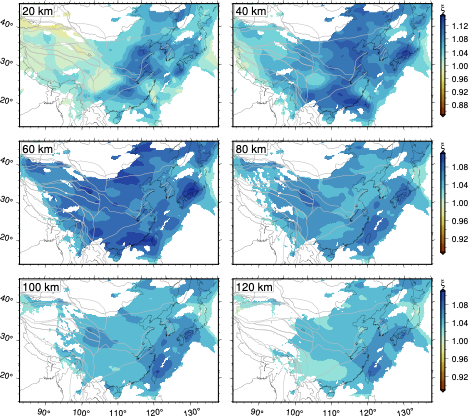Summary
KEA20 is a radially anisotropic model for the crust and mantle of East Asia derived from earthquake and ambient noise surface wave dispersion constraints in the period range 5-375 s including fundamental and overtone mode branches. The tomographic model is constructed using a local sensitivity kernel approach with respect to a reference 3-D model. Isotropic velocities are resolvable down to the mantle transition zone, while radial anisotropy is resolved down to approximately 120 km depth. Here, we provide absolute values for VSV, VSH, and Moho depth for both our tomographic model and the reference model.
Quicklinks
Description
| Name | KEA20 |
| Title | Radially anisotropic shear wave velocity model for East Asia |
| Type | 3-D Tomography Earth Model |
| Sub Type | Radially anisotropic S velocities (km/s) and Moho depth (km) |
| Year | 2021 |
| Data Revision | r0.0 (revision history) |
| Short Description | KEA20 is a radially anisotropic model for the crust and mantle of East Asia derived from earthquake and ambient noise surface wave dispersion constraints in the period range 5-375 s including fundamental and overtone mode branches. The tomographic model is constructed using a local sensitivity kernel approach with respect to a reference 3-D model. Isotropic velocities are resolvable down to the mantle transition zone, while radial anisotropy is resolved down to approximately 120 km depth. Here, we provide absolute values for VSV, VSH, and Moho depth for both our tomographic model and the reference model. |
| Authors: | Michael Witek, Department of Geophysics, Kangwon National University, Chuncheon, Republic of Korea Sung-Joon Chang, Department of Geophysics, Kangwon National University, Chuncheon, Republic of Korea Do Yoon Lim, Earthquake and Volcano Research Division, Korea Meteorological Administration, Seoul, Republic of Korea, Shuoxian Ning, School of Earth and Space Sciences, Peking University, Beijing, China Jieyuan Ning, School of Earth and Space Sciences, Peking University, Beijing, China |
| Previous Model | None |
| Reference Model | The reference model consists of a bilinearly interpolated CRUST1.0 (Laske et al., 2013) placed on top of the AK135 mantle (Kennett et al., 1995). |
| Model Download | KEA20.r0.0.nc (see metadata) model, KEA20-Moho.r0.0.nc (see metadata) model moho depth relative to a mean Earth radius of 6371 km, KEA20-reference-model.r0.0.nc (see metadata) reference model, in netCDF 3 Classic format. |
| Model Homepage | None |
| Depth Coverage | 0-660 km |
| Area | East Asia, Longitude: 70° E to 150° E, Latitude: 15° N to 51° N |
| Data Set Description | The dataset used to create KEA20 includes 268,888 Rayleigh and 69,147 Love wave dispersion curves from previously published studies (Ritzwoller and Levshin, 1998; Visser et al., 2008; Ekström, 2011; Ritsema et al., 2011; Ma et al., 2014; You and Chang, 2017; Min and Chang, 2017; Lim and Chang, 2018; Witek et al., 2018), as well as 299,193 Rayleigh and 116,029 Love wave dispersion curves newly measured from ambient noise and earthquake waveforms. We include fundamental and overtones up to the 5th mode branch. The period range is 5-375 s. For a more detailed description of the dataset please see Table 1 in Witek et al. (2021). |


Citations and DOIs
To cite the original work behind this Earth model:
- Witek, M., Chang, S.-J., Lim, D. Y., Ning, S., & Ning, J. (2021). Radial anisotropy in East Asia from multimode surface wave tomography. Journal of Geophysical Research: Solid Earth, 126, e2020JB021201. https://doi.org/10.1029/2020JB021201
To cite IRIS DMC Data Products effort:
- Trabant, C., A. R. Hutko, M. Bahavar, R. Karstens, T. Ahern, and R. Aster (2012), Data Products at the IRIS DMC: Stepping Stones for Research and Other Applications, Seismological Research Letters, 83(5), 846–854, https://doi.org/10.1785/0220120032.
DOI for this EMC webpage: https://doi.org/10.17611/dp/emc.2021.kea20.1
References
- Ekström, G. (2011). A global model of Love and Rayleigh surface wave dispersion and anisotropy, 25–250 s. Geophysical Journal International, 187, 1668–1686. https://doi.org/10.1111/j.1365-246X.2011.05225.x
- Kennett, B. L. N., Engdahl, E. R., & Buland, R. (1995). Constraints on seismic velocities in the Earth from traveltimes. Geophysical Journal International, 122, 108-124. https://doi.org/10.1111/j.1365-246X.1995.tb03540.x
- Laske, G., Masters, G., Ma, Z., & Pasyanos, M. (2013). Update on CRUST1.0 – A 1-degree global model of Earth’s crust. Geophysical Research Abstracts, 15 (EGU2013-2658).
- Lim, D., & Chang, S.-J. (2018). Three-dimensional S-wave velocity structure and radial anisotropy of crust and uppermost mantle beneath East Asia. Geophysics and Geophysical Exploration, 21(1), 33–40. https://doi.org/10.7582/GGE.2018.21.1.033
- Ma, Z., Masters, G., Laske, G., & Pasyanos, M. (2014). A comprehensive dispersion model of surface wave phase and group velocity for the globe. Geophysical Journal International, 199, 113–135. https://doi.org/10.1093/gji/ggu246
- Min, K., & Chang, S.-J. (2017). 3D SH-wave velocity structure of East Asia using Love-wave tomography and implication on radial anisotropy. Geophysics and Geophysical Exploration, 20(1), 25–32. https://doi.org/10.7582/GGE.2017.20.1.025
- Ritsema, J., Deuss, A., van Heijst, H. J., & Woodhouse, J. H. (2011). S40RTS: a degree-40 shear-velocity model for the mantle from new Rayleigh wave dispersion, teleseismic traveltime and normal-mode splitting function measurements. Geophysical Journal International, 184, 1223–1236. https://doi.org/10.1111/j.1365-246X.2010.04884.x
- Ritzwoller, M. H., & Levshin, A. L. (1998). Eurasian surface wave tomography: Group velocities. Journal of Geophysical Research, 103(B03), 4839–4878. https://doi.org/10.1029/97JB02622
- Visser, K., Trampert, J., & Kennett, B. L. N. (2008). Global anisotropic phase velocity maps for higher mode Love and Rayleigh waves. Geophysical Journal International, 172, 1016–1032. doi: https://doi.org/10.1111/j.1365-246X.2007.03685.x
- Witek, M., van der Lee, S., Kang, T.-S., Chang, S.-J., Ning, J., & Ning, S. (2018). S velocity model of East Asia from a cluster analysis of localized dispersion. Journal of Geophysical Research: Solid Earth, 123. https://doi.org/10.1029/2018JB016060
- You, S.-H., & Chang, S.-J. (2017). 3D SV-wave velocity structure of East Asia using Rayleigh-wave tomography. Geophysics and Geophysical Exploration, 20(1), 12–17. https://doi.org/10.7582/GGE.2017.20.1.012
Credits
- r0.0 model provided by Michael Witek.
Revision History
revision r0.0: uploaded June 2, 2021.
Timeline
- 2021-06-03
- online






